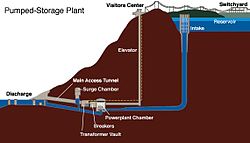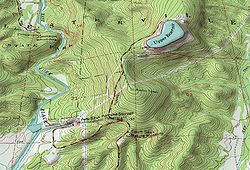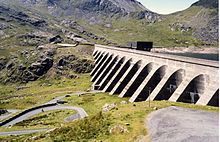- Pumped-storage hydroelectricity
-
Pumped-storage hydroelectricity is a type of hydroelectric power generation used by some power plants for load balancing. The method stores energy in the form of water, pumped from a lower elevation reservoir to a higher elevation. Low-cost off-peak electric power is used to run the pumps. During periods of high electrical demand, the stored water is released through turbines to produce electric power. Although the losses of the pumping process makes the plant a net consumer of energy overall, the system increases revenue by selling more electricity during periods of peak demand, when electricity prices are highest. Pumped storage is the largest-capacity form of grid energy storage now available.
Contents
Overview
At times of low electrical demand, excess generation capacity is used to pump water into the higher reservoir. When there is higher demand, water is released back into the lower reservoir through a turbine, generating electricity. Reversible turbine/generator assemblies act as pump and turbine (usually a Francis turbine design). Nearly all facilities use the height difference between two natural bodies of water or artificial reservoirs. Pure pumped-storage plants just shift the water between reservoirs, while the "pump-back" approach is a combination of pumped storage and conventional hydroelectric plants that use natural stream-flow. Plants that do not use pumped-storage are referred to as conventional hydroelectric plants; conventional hydroelectric plants that have significant storage capacity may be able to play a similar role in the electrical grid as pumped storage, by deferring output until needed.
Taking into account evaporation losses from the exposed water surface and conversion losses, approximately 70% to 85% of the electrical energy used to pump the water into the elevated reservoir can be regained.[1] The technique is currently the most cost-effective means of storing large amounts of electrical energy on an operating basis, but capital costs and the presence of appropriate geography are critical decision factors.
The relatively low energy density of pumped storage systems requires either a very large body of water or a large variation in height. For example, 1000 kilograms of water (1 cubic meter) at the top of a 100 meter tower has a potential energy of about 0.272 kW·h (capable of raising the temperature of the same amount of water by only 0.23 Celsius = 0.42 Fahrenheit). The only way to store a significant amount of energy is by having a large body of water located on a hill relatively near, but as high as possible above, a second body of water. In some places this occurs naturally, in others one or both bodies of water have been man-made. Projects in which both reservoirs are artificial and in which no natural waterways are involved are commonly referred to as "closed loop".
This system may be economical because it flattens out load variations on the power grid, permitting thermal power stations such as coal-fired plants and nuclear power plants and renewable energy power plants that provide base-load electricity to continue operating at peak efficiency (Base load power plants), while reducing the need for "peaking" power plants that use the same fuels as many baseload thermal plants, gas and oil, but have been designed for flexibility rather than maximal thermal efficiency. However, capital costs for purpose-built hydrostorage are relatively high.
Along with energy management, pumped storage systems help control electrical network frequency and provide reserve generation. Thermal plants are much less able to respond to sudden changes in electrical demand, potentially causing frequency and voltage instability. Pumped storage plants, like other hydroelectric plants, can respond to load changes within seconds.
The first use of pumped storage was in the 1890s in Italy and Switzerland. In the 1930s reversible hydroelectric turbines became available. These turbines could operate as both turbine-generators and in reverse as electric motor driven pumps. The latest in large-scale engineering technology are variable speed machines for greater efficiency. These machines generate in synchronization with the network frequency, but operate asynchronously (independent of the network frequency) as motor-pumps.
The first use of pumped-storage in the United States was in 1930 by the Connecticut Electric and Power Company, using a large reservoir located near New Milford, Connecticut, pumping water from the Houstatonic River to the storage reservoir 230 feet above. [2]
A new use for pumped storage is to level the fluctuating output of intermittent power sources. The pumped storage provides a load at times of high electricity output and low electricity demand, enabling additional system peak capacity. In certain jurisdictions, electricity prices may be close to zero or occasionally negative (Ontario in early September, 2006), on occasions that there is more electrical generation than load available to absorb it; although at present this is rarely due to wind alone, increased wind generation may increase the likelihood of such occurrences. It is particularly likely that pumped storage will become especially important as a balance for very large scale photovoltaic generation.[3]
Worldwide use of pumped-storage hydroelectricity
See also: List of pumped-storage hydroelectric power stationsIn 2008 world pumped storage generating capacity was 104 GW,[4] while other sources claim 127 GW, which comprises the vast majority of all types of utility grade electric storage.[5] The EU had 38.3 GW net capacity (36.8% of world capacity) out of a total of 140 GW of hydropower and representing 5% of total net electrical capacity in the EU. Japan had 25.5 GW net capacity (24.5% of world capacity).[4]
In 2009 the United States had 21.5 GW of pumped storage generating capacity (20.6% of world capacity) accounting for 2.5% of baseload generating capacity.[6] PHS generated (net) -6288 GWh of energy in 2008[7] because more energy is consumed in pumping than is generated.
Five largest operational pumped-storage plants are listed below:
Station Country Location Capacity (MW) Ref Bath County Pumped Storage Station  United States
United States38°12′32″N 79°48′00″W / 38.20889°N 79.8°W 2,772 [8] Guangdong Pumped Storage Power Station  China
China23°45′52″N 113°57′12″E / 23.76444°N 113.95333°E 2,400 [9][10] Okutataragi Hydroelectric Power Station  Japan
Japan35°14′13″N 134°49′55″E / 35.23694°N 134.83194°E 1,932 [11] Ludington Pumped Storage Power Plant  United States
United States43°53′37″N 86°26′43″W / 43.89361°N 86.44528°W 1,872 [12][13] Tianhuangping Pumped Storage Power Station  China
China30°28′13″N 119°36′21″E / 30.47028°N 119.60583°E 1,836 [14] Potential technologies
The use of underground reservoirs has been investigated. Recent examples include the proposed Summit project in Norton, Ohio, and the Mount Hope project in New Jersey, which was to have used a former iron mine as the lower reservoir. Several new underground pumped storage projects have been proposed. Cost estimates for these projects are higher than for surface projects, but their use might greatly expand the number of pumped storage sites.
A new concept is to use wind turbines or solar power to drive water pumps directly, in effect an 'Energy Storing Wind or Solar Dam'. This could provide a more efficient process and usefully smooth out the variability of energy captured from the wind or sun.[15][16] [17]
One can use pumped sea water to store the energy. The 30 MW Yanbaru project in Okinawa was the first demonstration of seawater pumped storage. A 300 MW seawater-based project has recently been proposed on Lanai, Hawaii, and several seawater-based projects have recently been proposed in Ireland. Another potential example of this could be used in a tidal barrage or tidal lagoon. A potential benefit of this arises if seawater is allowed to flow behind the barrage or into the lagoon at high tide when the water level is roughly equal either side of the barrier, when the potential energy difference is close to zero. Then water is released at low tide when a head of water has been built up behind the barrier, when there is a far greater potential energy difference between the two bodies of water. The result being that when the energy used to pump the water is recovered, it will have multiplied to a degree depending on the head of water built up. A further enhancement is to pump more water at high tide further increasing the head with for example intermittent renewables.[18] Downsides: the generator must be below sea level, and marine organisms would tend to grow on the equipment and disrupt operation. This is not a major problem for the EDF La Rance Tidal power station in France.
Instead of pumping water uphill, the pumped storage idea can be inverted, pumping air under water.
See also
- Grid energy storage
- Hydroelectricity
- Hydropower
- List of pumped-storage hydroelectric power stations
References
- ^ ESA - Pumped Hydro Storage
- ^ "A Ten-Mile Storage Battery." Popular Science, July 1930, p. 60.
- ^ Summary Energy from the Desert - Practical Proposals for Very Large Scale Photovoltaic Power Generation (VLS-PV) Systems
- ^ a b International Energy Statistics
- ^ Rastler et al. Electric Energy Storage Technology Options: A White Paper Primer on Applications, Costs, and Benefits. (Free download) EPRI, Palo Alto, CA, 2010. Accessed: 30 September 2011. ISBN 1020676
- ^ http://www.eia.doe.gov/oiaf/servicerpt/stimulus/excel/aeostimtab_9.xls
- ^ http://www.eia.doe.gov/cneaf/electricity/epm/table1_1.html
- ^ Bath County Pumped-storage Station, http://www.dom.com/about/stations/hydro/bath-county-pumped-storage-station.jsp, retrieved 2010-06-25
- ^ Pumped-storage hydroelectric power stations in China, http://www.industcards.com/ps-china.htm, retrieved 2010-06-25
- ^ (PDF) Guangzhou Pumped-storage Power Station, http://www.chincold.org.cn/news/li080321-9-Guangzhou.pdf, retrieved 2010-06-25
- ^ "2003-2004 Electricity Review in Japan". Japan Nuclear. http://www.japannuclear.com/files/Electricity%20Review%20Japan%202003-04.pdf. Retrieved 1 September 2010.
- ^ Dniester Pumped Storage Plant, Ukraine, http://www.bankwatch.org/project.shtml?apc=162059-1972478---1&s=1972478, retrieved 2010-09-01
- ^ Tymoshenko launches the first unit of Dnister Hydroelectric Power Plant, http://en.for-ua.com/news/2009/12/23/162625.html, retrieved 2010-09-01
- ^ "Tianhuangping Pumped-Storage Hydro Plant, China". Power-Technology.com. http://www.power-technology.com/projects/tianhuangping/. Retrieved 3 January 2011.
- ^ http://www.solarnavigator.net/alternative_energy.htm
- ^ http://www.inference.phy.cam.ac.uk/sustainable/refs/tide/WindPumpedStor.pdf in Renewable and Sustainable Energy Reviews
- ^ http://poppware.de/Storage_for_a_secure_Power_Supply_from_Wind_and_Sun.pdf
- ^ http://www.inference.phy.cam.ac.uk/sustainable/book/tex/Lagoons.pdf in Enhancing Electrical Supply by Pumped Storage in Tidal Lagoons
External links
Electricity generation Concepts Availability factor · Baseload · Black start · Capacity factor · Demand factor · Demand management · EROEI · Grid storage · Intermittency · Load following · Nameplate capacity · Peak demand · Repowering · Spark spreadSources Technology Distribution Demand response · Distributed generation · Dynamic demand · Electricity distribution · Electrical grid · High-voltage direct current · Load management · Pumped hydro · Negawatts · Smart grid · Substation · Super grid · TSO · Transmission tower · Utility polePolicies Carbon offset · Coal phase out · Ecotax · Energy subsidies · Feed-in tariff · Net metering · Pigovian tax · Renewable Energy Certificates · Renewable energy payments · Renewable energy policyCategories: Electric power distribution · Electricity economics · Power station technology · Portals: Energy · Sustainable developmentTopics related to Hydropower Hydroelectricity · Head · Discharge · Dam · Francis turbine · Kaplan turbine · Tyson turbine · Gorlov helical turbine · Pelton wheel · Turgo turbine · Banki turbine · Conventional power stations · Big rivers · Pumped-storage · Run-of-the-river · Low head · Small hydro · Micro hydro · Pico hydroCategories:- Dams
- Energy storage
- Pumped storage power stations
- Water conservation
Wikimedia Foundation. 2010.




